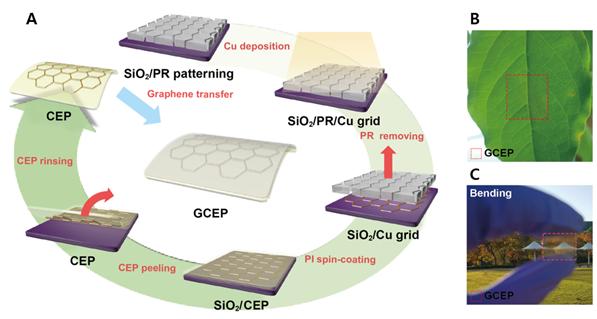An electrode has been developed that will greatly improve the stability of the "Perovskite Solar Cell", which is attracting attention as a next-generation solar cell due to its high efficiency and low cost. This is because transparent, flexible and highly conductive graphene is inserted to prevent the decomposition of the metal electrode used in the past.
A research team, led by Professor Hyesung Park in the School of Energy and Chemical Engineering at UNIST has developed a high-performance metal-based flexible transparent electrode with an interlayer of graphene. By using graphene with excellent impermeability, the metal-induced decomposition phenomenon, which has been identified as a chronic problem of metal-electrode-based perovskite solar cells, was suppressed to significantly improve stability. In addition, the efficiency and mechanical stability of the perovskite solar cell were significantly increased by using graphene's excellent electrical conductivity and mechanical durability.
A transparent and electron-transfer electrode is included in the'photoelectric device' that converts light energy into electrical energy (solar cell) or converts electrical energy into light energy (display device). Until now, metal oxide-based electrodes (ITO) were used, but they were hard and easily broken, making them difficult to apply to wearable devices. In particular, when this electrode is applied to a perovskite solar cell, there is a problem that the halogen element contained in the perovskite (photoactive layer) moves toward the metal oxide and the metal electrode and the photoactive layer are decomposed simultaneously.

The research team solved this issue by inserting a graphene layer. Graphene has high electrical conductivity and allows electrons to pass through well, but it has an'impermeability' that prevents atoms from moving. When graphene is inserted as an intermediate layer between the metal transparent electrode and the perovskite photoactive layer, electrons (charges) flow well but halogen elements cannot move. In addition, graphene itself is transparent and flexible, so it is also suitable for use as an electrode for photoelectric devices.

The research team applied a "metal-graphene hybrid flexible transparent electrode" with an interlayer of graphene to perovskite solar cells. The perovskite solar cell made in this way had a photoelectric conversion efficiency of 16.4% and maintained over 97.5% of the initial efficiency even after 1,000 hours. In addition, after 5,000 bending tests, it showed excellent mechanical durability such as maintaining 94% of the initial efficiency, and thus it was applicable to next-generation wearable devices.
"The new method of inserting graphene interlayer has significantly improved the efficiency and stability of the perovskite solar cells," says Professor Park. "We expected that this will greatly help in the development of various next-generation flexible photovoltaic devices based on perovskite, such as LEDs and smart sensors, as well as solar cells."
The findings of this research have been published online in Nano Letters on May 13, 2020. This work has been supported by the Basic Science Research Program through the National Research Foundation of Korea (NRF) funded by the Ministry of Science and ICT (MSIT). It has been also supported by the 2019 Research Fund of KOREA East-West Power Co., LTD (EWP).
Journal Reference
Gyujeong Jeong, Donghwan Koo, Jihyung Seo et al., "Suppressed Interdiffusion and Degradation in Flexible and Transparent Metal Electrode-Based Perovskite Solar Cells with a Graphene Interlayer," Nano Lett., (2020)






